Tamil Language

 Introduction
IntroductionThe name 'Tamil' is a little differently pronounced anglicized version of the three letter native name of the Dravidian language spoken mainly by people of Tamilnadu, a state in the Indian subcontinent. It belongs to the southern branch of the Dravidian languages. It is the official and administrative language of the State of Tamilnadu and the Union territory of Puduchery. It is one of the twenty-two scheduled languages of India.
From the pre-Christian days of the Indian cultural evolution it has gained the same prominence as the major northern languages, mainly Sanskrit. However it has maintained its tradition, uniqueness and identity as the expressive medium of a cultural community and earned the accolade of being the first Indian language to be declared as a Classical Language by the government of India in 2004. A classical language is defined to own a rich literature that is ancient with an independent tradition that arose mostly on its own. It has the credit of being one of the official languages in the countries of Sri Lanka and Singapore.
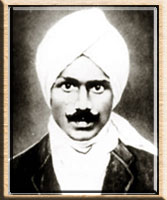 Tamil is also spoken by a significant minority in more than fifty five
diaspora countries of the world including Malaysia and Mauritius.Malayalam, the native language of the neighbouring state of Kerala is considered as the closest major relative of Tamil and its resemblance to Tamil is so striking that it almost sounds like a variation of Tamil language. Until about the 9th century, Malayalam was a dialect of ancient Tamil, also known as Proto-Tamil. Some believe that Proto-Tamil, the common stock of ancient Tamil and Malayalam, apparently diverged over a period of four or five centuries from the 9th century onwards, resulting in the emergence of Malayalam as a language distinct from Proto-Tamil.Tamil therefore, had a huge influence in the early development of Malayalam.
Tamil is also spoken by a significant minority in more than fifty five
diaspora countries of the world including Malaysia and Mauritius.Malayalam, the native language of the neighbouring state of Kerala is considered as the closest major relative of Tamil and its resemblance to Tamil is so striking that it almost sounds like a variation of Tamil language. Until about the 9th century, Malayalam was a dialect of ancient Tamil, also known as Proto-Tamil. Some believe that Proto-Tamil, the common stock of ancient Tamil and Malayalam, apparently diverged over a period of four or five centuries from the 9th century onwards, resulting in the emergence of Malayalam as a language distinct from Proto-Tamil.Tamil therefore, had a huge influence in the early development of Malayalam.
 Origin
OriginA few scholars have linked the origins of Tamil to that of Sanskrit. However, unlike most of the other established literary languages of India, the origins of Tamil are independent of Sanskrit. Tamil has the longest unbroken literary tradition amongst the four major Dravidian languages (Tamil, Telugu, Kannada and Malayalam). The earliest known Tamil inscriptions date back to at least 500 BC. The oldest literary text in Tamil, Tolkappiyam, was composed around 200 BC. The Tamil alphabet is thought to have evolved from the Brahmi script, though some scholars believe that its origins go back to the Indus script.
 Old Tamil (300 BCE-700 CE)
Old Tamil (300 BCE-700 CE)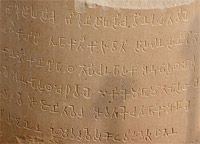 Short inscriptions supposedly relating to 2nd Century onwards, written in a variant of the Brahmi script called Tamil Brahmi, found in caves are the earliest records that stand in support of Old Tamil. The consonants, the syllable structure, and various grammatical forms are some of the many features of the Proto-Dravidian that the Old Tamil preserved. Just as in Proto-Dravidian, Old Tamil only had only two tenses, the past and the "non-past". Old Tamil verbs also had a distinct negative conjugation. Nouns could take pronominal suffixes like verbs to express ideas.
Short inscriptions supposedly relating to 2nd Century onwards, written in a variant of the Brahmi script called Tamil Brahmi, found in caves are the earliest records that stand in support of Old Tamil. The consonants, the syllable structure, and various grammatical forms are some of the many features of the Proto-Dravidian that the Old Tamil preserved. Just as in Proto-Dravidian, Old Tamil only had only two tenses, the past and the "non-past". Old Tamil verbs also had a distinct negative conjugation. Nouns could take pronominal suffixes like verbs to express ideas. Middle Tamil (700-1200)
Middle Tamil (700-1200)The evolution of Old Tamil into Middle Tamil by the 8th century, was characterized by a number of phonological and grammatical changes. The most important aspect was the emergence of the present tense. Middle Tamil also saw a significant increase in the Sanskritization of Tamil. From the period of the Pallava dynasty onwards, a number of words borrowed from Sanskrit found a place in Tamil. Likewise Sanskrit had also influenced Tamil grammar. The Tamil script too changed during the period of Middle Tamil. Tamil Brahmi and Vatteluttu, into which it evolved, were the main scripts used in Old Tamil inscriptions. From the 8th century onwards, however, a new script derived from the Pallava Grantha script which was used to write Sanskrit came to be used in place of Vatteluttu.
 Modern Tamil (1600-Present)
Modern Tamil (1600-Present)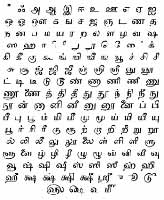 Colloquial spoken Tamil, shows a number of changes from the Middle Tamil. Modern spoken Tamil also shows a number of sound changes. However modern literary Tamil did not experience any transformation and followed the rules and norms of the grammar work Nannul. Contact with European languages also had its effects over both written and spoken Tamil. In the early 20th century, a new movement emphasizing the weeding out the Sanskrit and other foreign elements from Tamil erupted with the support of some political parties and nationalists with a
significant success. A significant amount of grammatical and syntactical change are seen among Old, Middle and Modern Tamil. However the core of the system of grammar remains unchanged all through these stages.
Colloquial spoken Tamil, shows a number of changes from the Middle Tamil. Modern spoken Tamil also shows a number of sound changes. However modern literary Tamil did not experience any transformation and followed the rules and norms of the grammar work Nannul. Contact with European languages also had its effects over both written and spoken Tamil. In the early 20th century, a new movement emphasizing the weeding out the Sanskrit and other foreign elements from Tamil erupted with the support of some political parties and nationalists with a
significant success. A significant amount of grammatical and syntactical change are seen among Old, Middle and Modern Tamil. However the core of the system of grammar remains unchanged all through these stages.
 Spoken and literary variant
Spoken and literary variantThe ancient form of the language or Sanga Tamil is the basis of classical literature; the formal style called Sentamil forms the basis of modern literature and a colloquial form, Koduntamil is the style of speech. In modern times, Sentamil is mostly used in textbooks, literary works and of public speaking and debate. In recent times, however, Koduntamil is gradually finding a significant role in these areas also.
 Writing System
Writing System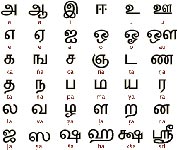 The current Tamil script consists of 12 vowels (Uyir Ezhuthukkal), 18 consonants (Mei Ezhuthukkal) and one special character, the Aytha Ezhuthu. The vowels and consonants combine to form 216 compound characters (Uyir Mei Ezhuthukkal), giving a total of 247 characters. The 18 Mei Ezhuthukkal have been sub divided into three categories viz. Vallinam, Mellinam and Idayinam containing 6 characters each according to the stress of the letters.
The current Tamil script consists of 12 vowels (Uyir Ezhuthukkal), 18 consonants (Mei Ezhuthukkal) and one special character, the Aytha Ezhuthu. The vowels and consonants combine to form 216 compound characters (Uyir Mei Ezhuthukkal), giving a total of 247 characters. The 18 Mei Ezhuthukkal have been sub divided into three categories viz. Vallinam, Mellinam and Idayinam containing 6 characters each according to the stress of the letters. Tamil Literature
Tamil LiteratureThe earliest Tamil literature goes back to the Sangam period perhaps from 600 BC-200 AD. The compilation of the corpus of literature produced in this Congress (Sangam) is known as the Sangam literature. Three sangams at Madura, Kapatapuram and northern Madura respectively are believed to have existed. Most of the works relating to the first two sangams dealt mainly with music and dance. Unfortunately Tolkappiyam is the only available work of these two Sangams. Tolkappiyam is a work on the grammar of the Tamil language and the earliest extant work of Tamil literature. It is written in the form of noorpaa (short formulaic compositions).
A collection of lyrics, known as Ettu-thokai or Eight Anthologies, and another one of longer poems, known as Pattu Pattu or Ten Idylls are the main literatures of the third Sangam. Sangam poetry is unique and unparalleled in terms of beauty and greatness. Natrinai, Kuruntogai, Ainkurunuru, Padirruppattu, Paripadal, Kalittogai, Ahanuru and Purananuru are the eight anthologis of Ettu-thokai. And Pattuppattu consists of the following ten idylls: Tirumurugarruppadai, Porunararruppadai, Cirupanarruppadai, Pattinappalai, Kurincippattu, Nedunalvadai, Maduraikkanci, Malaipadukadam, Mullaippattu and Perumpanarruppadai.
In third Sangam period, a collection of minor works called Padinen-kizhkkanakku which deals mainly with moral virtues was also produced. Among them, the most notable is Tiruvalluvar's Tirukkural or Kural with philosophy, ethics and wise maxims being the main emphasis. Mahatma Gandhi, India's father of the nation, said, I wanted to learn Tamil, only to enable me to study Valluvar's Thirukkural According to the Mahatma, "It is a treasure of wisdom.
 The Sangam literature, unlike the Rig Vedic texts, was secular in nature and revolved around the themes of various heroes and heroines. The Sangam literature provides very valuable information on the social, economic and political life of the people living in deltaic Tamil Nadu in the early Christian centuries. The post-Sangam period (200-600 AD) is notable for the composition of five great Tamil epics; Silappadikaram, Manimekalai, Jivaka chintamani, Valaiyapati and Kundalakesi. The five minor works viz. Yasodharakaviyam, Chulamani, Perunkathai, Nagakumara kaviyam and
Nilakesi are the contribution of some Jain authors.
The Sangam literature, unlike the Rig Vedic texts, was secular in nature and revolved around the themes of various heroes and heroines. The Sangam literature provides very valuable information on the social, economic and political life of the people living in deltaic Tamil Nadu in the early Christian centuries. The post-Sangam period (200-600 AD) is notable for the composition of five great Tamil epics; Silappadikaram, Manimekalai, Jivaka chintamani, Valaiyapati and Kundalakesi. The five minor works viz. Yasodharakaviyam, Chulamani, Perunkathai, Nagakumara kaviyam and
Nilakesi are the contribution of some Jain authors. Between 600-900 AD, the Tamil literature came under the influence of Saiva and Vaishnava saints called Nayanmars and Alvars respectively. The hymns of the Saiva saints were later collected into twelve anthologies called Tirumuraikal. The Periya Puranam, also called Tiruttondar Puranam, composed by Sekkizhar in the 12th century AD , was considered as the twelfth Tirumurai. The Vaishnavaite saint Nathamuni (824-924 AD) compiled the Vaishnava hymns into four books called Nalayira Divya Prabandham. Periyalivar, Poigaialvar, Bhutattalvar,Andal are some other Vaishnavaite saints who have done a meticulous work to the Tamil literature. Among them Andal is the only woman saint.
HISTORY OF TAMIL LITERATURE AND TAMIL PROSE
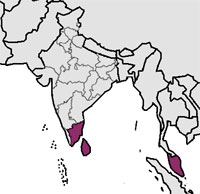 One of the great Tamil poets, Kamban, belonged to this period. He was the greatest of the court poets of Kulottunga Chola III (1178-1218 AD). He adapted Valmiki's Ramayana in Tamil in his Kamba Ramayanam, which is very unique in its style and technique. He also composed other works like Erelupadu and Sathakoparandadi. The other great poets of this period include Ottakkuttan, Pugazhendi, Auvaiyar, Jayankondan, Iraiyanar, Kalladanar, Pavananti. Another important poet who flourished during the Chola period was Kuttan, who authored great works like Nalayirakkovai, Parani, Tukkayagapparani, Sarasvatiyandadi and Arumbaittollayiram. Other noted scholars of the Chola period include Kuttan, Tirutakadevara Talamokti, and Venkatamadhava.
One of the great Tamil poets, Kamban, belonged to this period. He was the greatest of the court poets of Kulottunga Chola III (1178-1218 AD). He adapted Valmiki's Ramayana in Tamil in his Kamba Ramayanam, which is very unique in its style and technique. He also composed other works like Erelupadu and Sathakoparandadi. The other great poets of this period include Ottakkuttan, Pugazhendi, Auvaiyar, Jayankondan, Iraiyanar, Kalladanar, Pavananti. Another important poet who flourished during the Chola period was Kuttan, who authored great works like Nalayirakkovai, Parani, Tukkayagapparani, Sarasvatiyandadi and Arumbaittollayiram. Other noted scholars of the Chola period include Kuttan, Tirutakadevara Talamokti, and Venkatamadhava.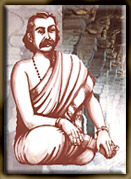 As far as the modern period is concerned, Umaruppulavar (1605-1703 AD) composed a verse on the life of Prophet Muhammad, called the Sirappuranam. He was the earliest Muslim Tamil poet. Following him Mohamed Ibrahim wrote Muhaidin Puranam (1845 AD).An Italian Christian missionary, Constanzio Beschi (1680-1747 AD), under a pseudonym as 'Viramamunivar', wrote a classic Tembavani, on the life of Jesus Christ.
As far as the modern period is concerned, Umaruppulavar (1605-1703 AD) composed a verse on the life of Prophet Muhammad, called the Sirappuranam. He was the earliest Muslim Tamil poet. Following him Mohamed Ibrahim wrote Muhaidin Puranam (1845 AD).An Italian Christian missionary, Constanzio Beschi (1680-1747 AD), under a pseudonym as 'Viramamunivar', wrote a classic Tembavani, on the life of Jesus Christ. The name Subramanya Bharati (1882-1921 AD), one of the greatest of Tamil litterateurs of the modern times, is synonymous with patriotic and devotional songs and intense prose writings on contemporary social affairs. Panchali Sabadam, an epic poem based on the Mahabharata, Kalippattu, Kannanpattu and Kuyilpattu are his great works. V.O.Chidambaram's Meyyarivu and Padal Tirattu; Desikavinayagam's Malarummalaiyum and Umarkkayyam-padalkal; Kalyanasundaram's Podumai Vettal, Tamiizhan Idayam and Sankoli; N.K.Ramalingam's Avalum Avanum are some of the note worthy poetic works. Bharatidasan is a well known for his poetic works Azhakin Sirippu, Pandiyan Parisu, Tamizhiyakkam, Kudumbavilakku, etc.The other renowned poets of this period include M.L.Thangappa, Mudiyarasan, Ezhilmutalvan, N.Kanakaraja Iyer, A.Srinivasaraghavan, Kannadasan and Tamizhazhagan.
Viramamunivar's Paramartta Gurukathai of the 18th century is the earliest novel written in Tamil. However, Pirataba Mudaliyar charittiram written by Vedanayagam Pillai in 1875 only is considered as the first Tamil novel. The other important works of this period include Bharatam of Perundevanar, Kamalambalcharittiram of Rajam Ayyar, Padmavatichaittiram of Madhaviah, Menaka and Balamani of Vaduvur Duraiswamy, Ratnapurirahasyam of A.Kuppuswamy, Mannasai and Kariyadarisi of Shankara Ram etc.M.Varadarajan, C.N.Annadurai, Akilan, Anuttama, Jayalakshmi Srinivasan, Kodainayaki Ammal, N.Parthsarthy, C.Subramanyam, Jayakantan and Sundaram Ramaswamy. V.V.S.Aiyar,Kalki, Pudumaippittan, B.S.Ramayya and ASP Ayyar are some of the eminent novel and short story writers who added credit to Tamil.


